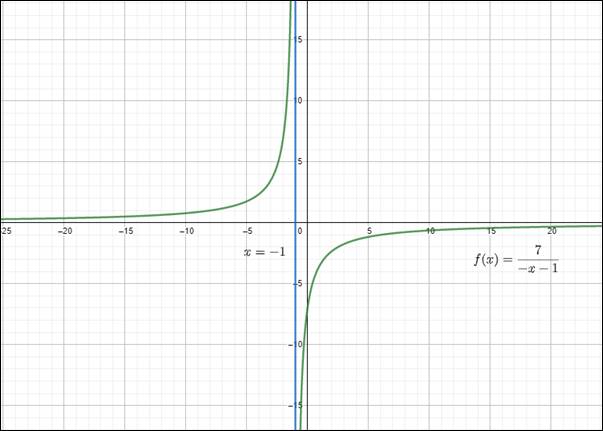
The graph of the given function and hence find its asymptotes.
Answer to Problem 107E
The given function has two asymptotes, a vertical asymptote x = -1 and a horizontal asymptote y = 0.
Explanation of Solution
Given: The given function is
Concept Used: Consider any rational function
Vertical asymptotes of the function are given by
Horizontal asymptotes of the function are given by
Oblique asymptotes of the function are given by the linear part in the quotient after long division. Hence, if
Graph: The graph of the given function is-

Interpretation: The given function is
The points through which the given curve passes through are-
| x | |
| 0 | -7 |
| 6 | -1 |
| -8 | 1 |
| 14 | |
| -14 | |
| 2 |
Vertical asymptote of the function is given by
Horizontal asymptote of the function is given by
Since the degree of the function in the numerator is less than that of the denominator, hence the given function has no oblique asymptotes.
Thus the given function is a reciprocal function with two asymptotes, which are
Chapter 7 Solutions
PRECALCULUS W/LIMITS:GRAPH.APPROACH(HS)
 Calculus: Early TranscendentalsCalculusISBN:9781285741550Author:James StewartPublisher:Cengage Learning
Calculus: Early TranscendentalsCalculusISBN:9781285741550Author:James StewartPublisher:Cengage Learning Thomas' Calculus (14th Edition)CalculusISBN:9780134438986Author:Joel R. Hass, Christopher E. Heil, Maurice D. WeirPublisher:PEARSON
Thomas' Calculus (14th Edition)CalculusISBN:9780134438986Author:Joel R. Hass, Christopher E. Heil, Maurice D. WeirPublisher:PEARSON Calculus: Early Transcendentals (3rd Edition)CalculusISBN:9780134763644Author:William L. Briggs, Lyle Cochran, Bernard Gillett, Eric SchulzPublisher:PEARSON
Calculus: Early Transcendentals (3rd Edition)CalculusISBN:9780134763644Author:William L. Briggs, Lyle Cochran, Bernard Gillett, Eric SchulzPublisher:PEARSON Calculus: Early TranscendentalsCalculusISBN:9781319050740Author:Jon Rogawski, Colin Adams, Robert FranzosaPublisher:W. H. Freeman
Calculus: Early TranscendentalsCalculusISBN:9781319050740Author:Jon Rogawski, Colin Adams, Robert FranzosaPublisher:W. H. Freeman
 Calculus: Early Transcendental FunctionsCalculusISBN:9781337552516Author:Ron Larson, Bruce H. EdwardsPublisher:Cengage Learning
Calculus: Early Transcendental FunctionsCalculusISBN:9781337552516Author:Ron Larson, Bruce H. EdwardsPublisher:Cengage Learning





